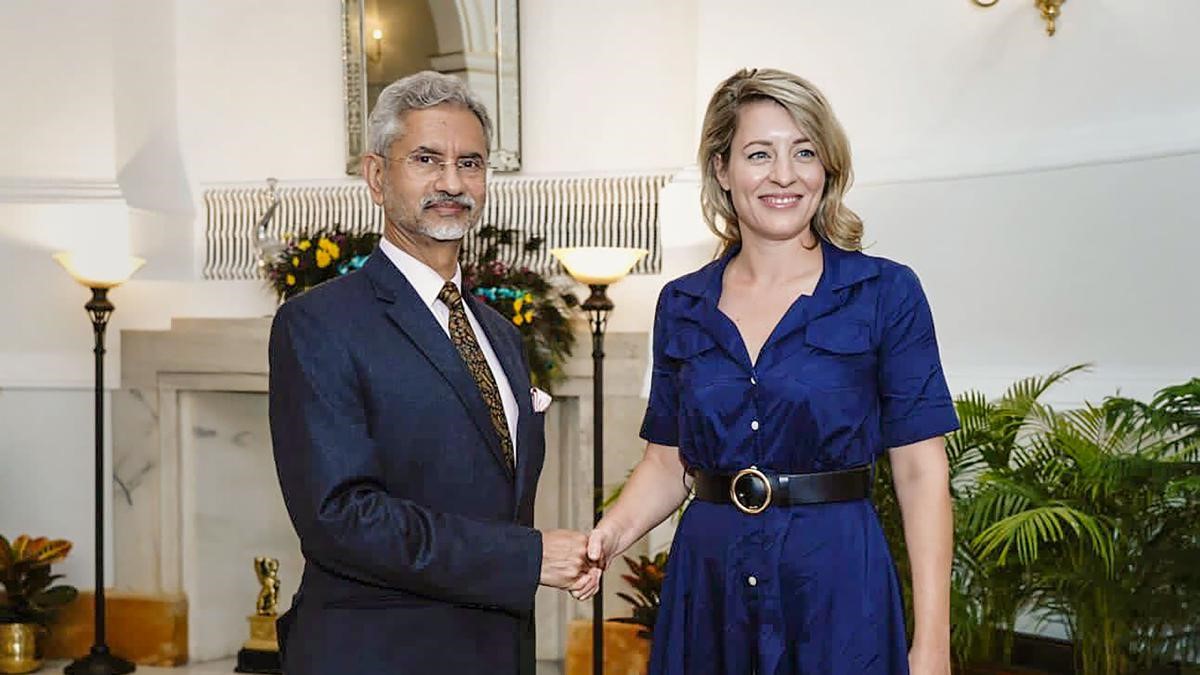
Disclaimer: Copyright infringement not intended.
Context: Indo-Pacific cooperation and trade were at the top of the agenda as Canadian Foreign Minister met with External Affairs Minister S. Jaishankar for the India-Canada Strategic Dialogue in Delhi
Details:
Canadian Indo-Pacific strategy:
- Canada’s new Indo-Pacific Strategy seems to reflect such geopolitical and geoeconomic alignments. Terming the Indo-Pacific, to which it also belongs, as “a new horizon of opportunity,” Canada, through this strategy, has identified four regions to focus on – China, India, the North Pacific (Japan and Koreas) and ASEAN.
- The Canadian strategy document released contains sharp words on China’s “coercive” challenge to the international rules-based order and on human rights, and in contrast says India and Canada have a “shared tradition of democracy and pluralism, a common commitment to a rules-based international system and multilateralism, mutual interest in expanding our commercial relationship and extensive and growing people-to-people connections“.
- Incidentally, Ottawa acknowledges that “people of Indo-Pacific origin” (it has identified 40 countries) constitute the largest diaspora in Canada. “1 in 5 Canadians have family ties to the region,” and “it is also home to 60% of Canada’s international students”.
- Canada realizes that as many of its “closest allies, including the United States, the European Union, Germany, France, and the United Kingdom, have increased or are considering increasing their presence in the region
- Indo-Pacific is rapidly becoming the global center of economic dynamism and strategic challenge
.jpeg)
What is the Indo-Pacific?
- An alternative to the long-dominant “Asia-Pacific,” which signified the eastward movement of global developments from the Euro-Atlantic dimension, is the Indo-Pacific.
- Geographically, it is a theatre that combines the Pacific Ocean, the Indian Ocean, and the surrounding land masses.
Significance of the visit:
- Joly’s visit is particularly significant, as she is due to visit Delhi again next month again for the G-20 Foreign Minister’s meeting and the G-20 summit later this year, but chose to travel to India for a stand-along visit expected to pave the way for a continued reset in India-Canada ties after a freeze between 2020-2022 over a number of issues including attacks on Indian-origin people and establishments by Khalistani groups in Canada, Canadian comments over India’s farmer protests and India’s cancellation of diplomatic talks in response.
- The visit is seen as an attempt by both sides to put bilateral ties back on track, after several turbulent years, and focused primarily on Canada’s newly released Indo-Pacific strategy that calls India an important partner.
- Significantly, the MEA press release made no mention of recent tensions over vandalism by suspected pro-Khalistani groups in Canada.
- Prime Minister Narendra Modi met with Canadian PM Justin Trudeau in June last year, and is expected to welcome him for the G-20 summit in Delhi in September this year as well.
- 2023 could become the year of India-Canada reset, given the Indo-Pacific strategy convergence, trade talks which could culminate in an Early Progress Trade Agreement [EPTA], and a number of high-level meetings this year.
- Apart from encouraging investment from Canadian funds, India is also negotiating the EPTA, ahead of a Comprehensive Economic Partnership Agreement (CEPA).
- From Cleantech to critical minerals and education programs, there is a demand in India for what Canadians make, and grow
Indian context:
- The importance of the Indo-Pacific region in India’s foreign policy cannot be understated.
- There is growing convergence of global powers on the Indo-Pacific, evident from the proliferation of bilateral and multilateral initiatives in the region, in which India is increasingly a participant.
- The intensifying contestation and provocations, led by China, underscores the necessity for India to identify a pragmatic and strategic role for itself in the Indo-Pacific.
- The time is right to have a renewed focus on regional geopolitics – and no region is now more important than the Indo-Pacific.
Opportunities available for India to contribute to strengthening the region’s various dimensions:
1) Energy and Environment: Growth in the Indo-Pacific region can be led by mobilising emerging technologies like green hydrogen and bringing into focus avenues like blue economy where existing frameworks and mechanisms can be leveraged for closer economic cooperation.
2) Economy and Trade Linkages: Trade and economics encompass a major domain for the Indo-Pacific region. India’s approach to regional finance and credit, supply chain resilience and the soft power India draws from its historic diaspora network are its key strengths.
3) Security: Underlying the Indo-Pacific is the security domain. Delving into cybersecurity, maritime security and human security in the Indo-Pacific give a multi-dimensional view of the issues in the region.
4) Science and Technology: Technological exchange is essential in the Indo-Pacific region where countries have diverse capabilities. India can contribute towards collaboration on data, digitisation and earth observation satellites by leveraging its existing infrastructure and technical capability.
What forces are causing the world to turn to the Indo-Pacific?
- Vast Natural Resources
- China as a factor
- Non- Traditional Threats: piracy, illegal fishing, human trafficking, terrorism, and environmental dangers.
- Region makes up:
- 65% of the global population,
- 44% of the planet’s surface area,
- 2% of global GDP,
- 46% of global trade in goods.
India’s Policy for Indo-Pacific:
- A free, open, inclusive region.
- A common rules-based order for the region
- Equal access to common spaces on sea and in the air, as a right under international law
- Circumventing power rivalries through partnerships
- India aims to be a Net Security Provider, offer humanitarian assistance and acquire a solid and comprehensive strategic situational awareness of developments in the IOR.

India-Canada Bilateral Relations:
Overview: India-Canada bilateral ties are underpinned by shared values of democracy, pluralism, expanding economic engagement, regular high-level interactions and long-standing people-to-people ties.
High-level Exchanges: There have been a series of high-level visits and meetings of bilateral mechanisms.
Parliamentary Friendship Group: As Westminster style democracies, India and Canada share commonalities in Parliamentary structure and procedures. After general election in October 2019, Mr. Raj Saini, MP from the House of Common has been appointed as the Chair of the Canada-India Parliamentary Association. The last such group had 80 members and there have been parliamentary exchanges in the past.
Bilateral Mechanisms: Both sides pursue bilateral relations through the dialogue mechanisms such as Ministerial level- Strategic, Trade and Energy dialogues; Foreign Office Consultations; and other sector specific joint working groups (JWG).
People-to-People Relations: Canada hosts one of the largest Indian diasporas in the world, numbering 1.6 million (PIOs and NRIs) which account for more than 3% of its total population. In the field of politics, in particular, the present House of Commons (total strength of 338) has 22 Members of Parliament of Indian-origin.
Economic Relations:
- Bilateral trade in goods amounted to USD 6.73 billion in 2019-20 (India's exports : USD 2.85 billion and India's imports: USD 3.88 billion) which is well below the potential of two countries growing relations. The bilateral trade in Services in 2019 was USD 3.10 billion.
- Canadian Pension Funds have cumulatively pledged to invest around US$ 50 billion in India and are increasingly viewing India as a trending destination for investments.
- More than 600 Canadian companies have a presence in India, and more than 1,000 companies are actively pursuing business in the Indian market.
- Major items of India's exports to Canada include gems, jewelry and precious stones, pharmaceutical products, ready-made garments, mechanical appliances, organic chemicals, light engineering goods, iron & steel articles, etc. India’s imports from Canada include pulses, newsprint, wood pulp, asbestos, potash, iron scrap, copper, minerals and industrial chemicals, etc.
CEPA & BIPPA: India and Canada are discussing Comprehensive Economic Partnership Agreement (CEPA) and Bilateral Investment Promotion and Partnership Agreement (BIPPA/FIPA).
Energy Cooperation: Energy has been a primary area of our focus, considering that Canada is an ‘energy superpower’ with one of the world’s largest resources of uranium, natural gas, oil, coal, minerals and advanced technologies in hydropower, mining, renewable energy and nuclear energy.
Civil Nuclear Cooperation: A Nuclear Cooperation Agreement (NCA) with Canada was signed in June 2010 and came into force in September 2013.The Appropriate Arrangement (AA) for the NCA was signed in March 2013, under which a Joint Committee on Civil Nuclear Cooperation was constituted.
Science and Technology: Indo-Canadian S&T cooperation has been primarily focussed on promoting Industrial R&D which has potential for application through development of new IP, processes, prototypes or products.
Biotechnology: Department of Biotechnology (DBT) under IC-IMPACTS program implements joint research projects in health care, agri-biotech and waste management.
Information Technology: A Memorandum of Understanding on Cooperation in Information and Communication Technology and Electronics (ICTE) was signed in 2012 for 5 years.
Space: India and Canada are pursuing successful cooperative and commercial relations in the field of Space since 1990s mainly on space science, earth observation, satellite launch services and ground support for space missions..
Education:
- Education is a key area of mutual interest. Recently India became the top source of foreign students with 230,000 Indian students studying in Canada. There are about 300 MoUs between institutions of higher learning in India and Canada.
- The MoU on Higher Education (2010) with Canada was renewed in February 2018.
- The Shastri Indo-Canadian Institute (SICI)is a unique bi-national organization fostering, since 1968, education and cultural cooperation and collaboration between India and Canada.
Defence: India and Canada collaborate closely in international fora, particularly through the UN, Commonwealth and G-20.
Security Cooperation: The two countries have signed a Mutual Legal Assistance Treaty in 1994 (operationalised in 1998) and Extradition Treaty in 1987. The Joint Working Group on Counter Terrorism was set up in 1997. There is substantial engagement on counter terrorism issues particularly through the framework of the Joint Working Group (JWG) on Counter Terrorism.
Agriculture: The bilateral MoU on agriculture cooperation was signed at the federal level in 2009. A Joint Working Group has been set up under the MoU.
Track 1.5 Dialogue: India-Canada has established a Track 1.5 Dialogue on involving experts, government officials and business leaders from both sides to explore the possibility of future cooperation
Cultural Exchanges: Given that people-to-people ties form the bedrock of the India-Canada relationship, cultural exchanges remain vital.
India-Canada COVID-19 Collaboration:
- Supply of Hydroxichloroquine (HCQ) to Canada
- EAM joined Ministerial Coordination Group on COVID-19 (MCGC)
- Evacuation of stranded Indian and Canadian nationals from each others' countries and Air Bubble operations
- Development of COVID-19 vaccines


















